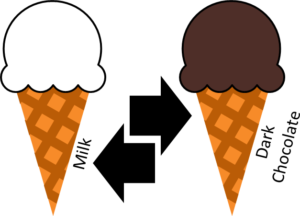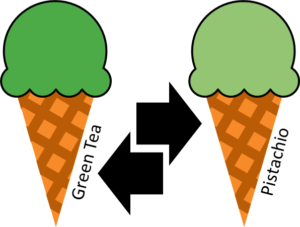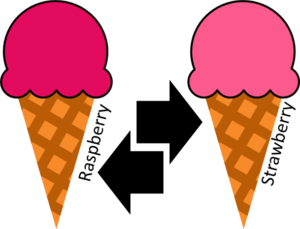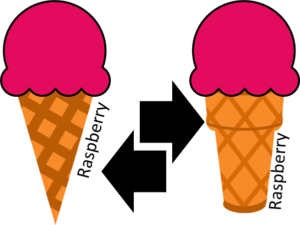 The sequence of your changeover can have quite an impact on the duration of the changeover. In this series of posts I will show some approaches on how to improve your changeover durations by carefully sequencing the products. This was initially intended to be one post, but as so often happens, it turned out to be more complex than initially thought, and hence I have split it into two posts. The next post will appear next week.
The sequence of your changeover can have quite an impact on the duration of the changeover. In this series of posts I will show some approaches on how to improve your changeover durations by carefully sequencing the products. This was initially intended to be one post, but as so often happens, it turned out to be more complex than initially thought, and hence I have split it into two posts. The next post will appear next week.
Introduction
 This is now my fourth post in sequence on SMED. After What to Do with SMED: Reduce Lot Size or Increase Work Time?, The Phases of a Changeover, and On Running Changeovers, I will now go into detail on the sequencing of changeovers (after doing a three-post series on SMED already in 2014). It was not planned that way, but I just happened to pick changeover-related topics for my next posts by chance. I am surprised myself by how much more detail there is on the topic of changeovers.
This is now my fourth post in sequence on SMED. After What to Do with SMED: Reduce Lot Size or Increase Work Time?, The Phases of a Changeover, and On Running Changeovers, I will now go into detail on the sequencing of changeovers (after doing a three-post series on SMED already in 2014). It was not planned that way, but I just happened to pick changeover-related topics for my next posts by chance. I am surprised myself by how much more detail there is on the topic of changeovers.
Anyway. Some machines have the same changeover time regardless of which product you change from and which product you change to. More commonly, however, is that at least some changeover durations vary depending on which product you come from and which product you go to. For this and the next post I will be using an (imaginary) example of ice cream manufacturing, hoping that you can enjoy some of the nice stuff too 🙂 .
Reasons for Different Changeover Times
Material-Related Changeover Differences
 In some cases, the reason for a different changeover time is related to the material. Let’s stick with the ice cream example.
In some cases, the reason for a different changeover time is related to the material. Let’s stick with the ice cream example.
If you are changing from dark chocolate ice cream to white milk ice cream, you have to make sure the system is very carefully cleaned. Any smudge of dark chocolate remaining will stand out in the white milk ice cream. The other way around, however, will not be as much of a problem. Even if there is a bit of milk ice cream left, it will not be noticeable in the mass of dark chocolate.
This is a very common approach to reduce changeover times (e.g., in polymer processing and injection molding). You always try to go from a light color to a darker color to reduce cleaning effort and to allow a faster changeover.
 Color may be only one product-related aspect here, and – depending on your product – there may be many more. Again, let me use an ice cream example. If you change from green tea ice cream to pistachio, the color does not matter much.
Color may be only one product-related aspect here, and – depending on your product – there may be many more. Again, let me use an ice cream example. If you change from green tea ice cream to pistachio, the color does not matter much.
However, pistachio is a nut, and many people are allergic to nuts. Hence, when changing from pistachio to green tea, you again have to clean extra carefully so as not to contaminate the green tea ice cream with nut allergens. The other way around is usually much less of a problem. While allergy to green tea exists, it is very rare. Of course, the machine is still cleaned, but a small oversight is unlikely to lead to a medical emergency.
In sum, depending on one or more of your material properties, it may be easier to change material in one direction than in another.
Machine-Related Changeover Differences
 Probably more common than material-related changeover differences are machine- or tool-related changeover differences. For some very similar products, you may have to change few tools/adjust few settings, or none at all. In all likelihood, the more different the products are, the more tools have to be changed.
Probably more common than material-related changeover differences are machine- or tool-related changeover differences. For some very similar products, you may have to change few tools/adjust few settings, or none at all. In all likelihood, the more different the products are, the more tools have to be changed.
 Again, ice cream: Changing raspberry to strawberry or the other way round is usually very simple. Just flush out the remaining old berry ice cream, fill up with the new berry, ensure the product coming out at the end meets specifications, and you are done.
Again, ice cream: Changing raspberry to strawberry or the other way round is usually very simple. Just flush out the remaining old berry ice cream, fill up with the new berry, ensure the product coming out at the end meets specifications, and you are done.
It is, however, probably more difficult to change the cone type. Even going from raspberry to raspberry, changing the cone may require a different tool as well as more extensive adjustments of the settings. Hence, this changeover may take longer due more to the tool change than to a simple change of the ice cream type.
A Note on Flexibility

Overall, you try to arrange your changeovers in a sequence that allows faster and easier changeovers. Using such a changeover-optimized production sequence will reduce your changeover time. However, it will also reduce your flexibility! You can no longer produce any product anytime, but you are constrained by this sequence.
Usually, this sequencing constraint may require slightly more inventory to cover the increased inflexibility (see my post Why Do We Have Inventory?). While this is not often talked about, having a fixed pattern usually requires slightly more inventory to cover any unforeseen circumstances.
On the other hand, however, shorter changeover times may allow you to changeover more often (See my post What to Do with SMED: Reduce Lot Size or Increase Work Time?). Details again depend on the situation on your shop floor, but my but feeling is that in many cases you may need slightly less material than before.
When Things Go Wrong: Firefighting!

If there is an urgent product needed out of your predetermined sequence, you either have to wait for this product to come up again in this sequence (or the next if it is too late already). Doing it out of sequence will potentially cause higher changeover durations when changing to the urgent product.
Additionally, you may have higher changeover durations afterward too, when you change back to the next product in normal sequence. Yet, this second longer changeover is usually better than completely rescheduling all the upcoming production to match the new point in the sequence. The details again depend on the situation on your shop floor.
Summary
Well, this was the first of this two-post series on changeover sequencing (out of a more or less accidental five-post series on changeovers). You should now understand why changeovers differ depending on the sequence, and their impact on flexibility. In my next post I will show you how to approach such an optimization. There will be the all-encompassing but unwieldy changeover matrix, which will give a much easier to use and practical changeover sequence or wheel. Until then, stay tuned, enjoy some ice cream, and organize your industry!

Very good point on fire fighting. I have never seen a factory where a “perfect” production plan sequence would last for longer than 2 weeks without interruption.
I actually haven’t even seen a plant where the sequence lasted even two weeks. In my experience the average is less than three days 🙂